Comparison of FLACS and BASiL Model for Ro-Pax Ferry LNG Bunkering Leak Analysis
Abstract
:1. Introduction
2. Materials and Methods
3. Results and Discussion
3.1. FLACS Coarse Grid Results
3.2. FLACS Refined Grid Results
4. Conclusions
Author Contributions
Funding
Institutional Review Board Statement
Informed Consent Statement
Data Availability Statement
Acknowledgments
Conflicts of Interest
References
- DNV GL. Mark Irvine Energy Transition Outlook 2019—A Global and Regional Forecast to 2050; DNV GL: Høvik, Norway, 2019. [Google Scholar]
- DNV GL. Mark Irvine Energy Transition Outlook 2020 Executive Summary; DNV GL: Høvik, Norway, 2020. [Google Scholar]
- ISO 20519:2017; Ships and Marine Technology—Specification for Bunkering of Liquefied Natural Gas Fuelled Vessels. BSI Standards: Hong Kong, China, 2017; ISBN 978-0-580-89936-2.
- Jeong, B.; Lee, B.S.; Zhou, P.; Ha, S. Man Evaluation of Safety Exclusion Zone for LNG Bunkering Station on LNG-Fuelled Ships. J. Mar. Eng. Technol. 2017, 16, 121–144. [Google Scholar] [CrossRef] [Green Version]
- Ikealumba, W.C.; Wu, H. Some Recent Advances in Liquefied Natural Gas (LNG) Production, Spill, Dispersion, and Safety. Energy Fuels 2014, 28, 3556–3586. [Google Scholar] [CrossRef]
- Process Hazard Analysis Software—PHAST. Available online: https://www.dnv.com/software/services/phast/index.html (accessed on 9 July 2022).
- ALOHA Software. Available online: https://www.epa.gov/cameo/aloha-software (accessed on 9 July 2022).
- Carboni, M.; Pio, G.; Vianello, C.; Mocellin, P.; Maschio, G.; Salzano, E. Numerical Simulation of LNG Dispersion in Harbours: A Comparison of Flammable and Visible Cloud. Chem. Eng. Trans. 2022, 90, 355–360. [Google Scholar] [CrossRef]
- Carboni, M.; Pio, G.; Mocellin, P.; Vianello, C.; Maschio, G.; Salzano, E. Accidental Release in the Bunkering of LNG: Phenomenological Aspects and Safety Zone. Ocean Eng. 2022, 252, 111163. [Google Scholar] [CrossRef]
- Gerbec, M.; Vidmar, P.; Pio, G.; Salzano, E. A Comparison of Dispersion Models for the LNG Dispersion at Port of Koper, Slovenia. Saf. Sci. 2021, 144, 105467. [Google Scholar] [CrossRef]
- Society for Gas as a Marine Fuel Recommendation of Controlled Zones during LNG Bunkering. 2018. Available online: https://www.sgmf.info/ (accessed on 7 July 2022).
- FLACS-CFD 20.1 User’s Manual. Available online: https://support.flacs.com/support/login (accessed on 11 July 2022).
- Koopman, R.P.; Cederwall, R.T.; Ermak, D.L.; Goldwire, H.C.; Hogan, W.J.; McClure, J.W.; McRae, T.G.; Morgan, D.L.; Rodean, H.C.; Shinn, J.H. Analysis of Burro Series 40-M3 Lng Spill Experiments. J. Hazard. Mater. 1982, 6, 43–83. [Google Scholar] [CrossRef]
- Puttock, J.S.; Blackmore, D.R. Field Experiments on Dense Gas Dispersion. J. Hazard. Mater. 1982, 6, 13–41. [Google Scholar] [CrossRef]
- Chan, S.T. Numerical Simulation of LNG Vapor Dispersion from a Fenced Storage Area. J. Hazard. Mater. 1992, 30, 195–224. [Google Scholar] [CrossRef]
- Suhas, V. Patankar Numerical Heat Transfer and Fluid Flow, 1st ed.; CRC Press: Boca Raton, FL, USA, 1980. [Google Scholar]
- Monin, A.S.; Obukhov, A.M. Basic Laws of Turbulent Mixing in the Surface Layer of the Atmosphere. Tr. Akad. Nauk SSSR Geofiz. 1959, 24, 163–187. [Google Scholar]
- Golder, D. Relations among Stability Parameters in the Surface Layer. Bound.-Layer Meteorol. 1972, 3, 47–58. [Google Scholar] [CrossRef]
- Adinda Windu Karsa. Available online: https://www.marinetraffic.com/en/ais/details/ships/shipid:2969507/mmsi:525003465/imo:9713789/vessel:ADINDA_WINDU_KARSA (accessed on 24 July 2021).
- Roache, P.J. Verification and Validation in Computational Science and Engineering/by Patrick J. Roache; Hermosa: Albuquerque, NM, USA, 1998; ISBN 0913478083. [Google Scholar]
- Hong Kong Observatory. Available online: https://www.hko.gov.hk/en/cis/climat.htm (accessed on 24 July 2021).
- Nubli, H.; Sohn, J.M. CFD-Based Simulation of Accidental Fuel Release from LNG-Fuelled Ships. Ships Offshore Struct. 2020, 17, 339–358. [Google Scholar] [CrossRef]
- Joubert, L.; Leroy, G.; Betteridge, S.; Vyazmina, E.; Bernard, L. Presentation of the Experimental JIP SPARCLING: Inside and beyond a Pressurised LNG Release. In Proceedings of the 13th International Symposium on Hazards, Prevention, and Mitigation of Industrial Explosions, Braunschweig, Germany, 27 July–31 August 2020; pp. 2–11. [Google Scholar]
- Wood, D.A. Predicting Saturated Vapor Pressure of LNG from Density and Temperature Data with a View to Improving Tank Pressure Management. Petroleum 2020, 7, 91–101. [Google Scholar] [CrossRef]
- Mariotti, A.; Galletti, C.; Brunazzi, E.; Salvetti, M.V. Steady Flow Regimes and Mixing Performance in Arrow-Shaped Micro-Mixers. Phys. Rev. Fluids 2019, 4, 034201. [Google Scholar] [CrossRef]
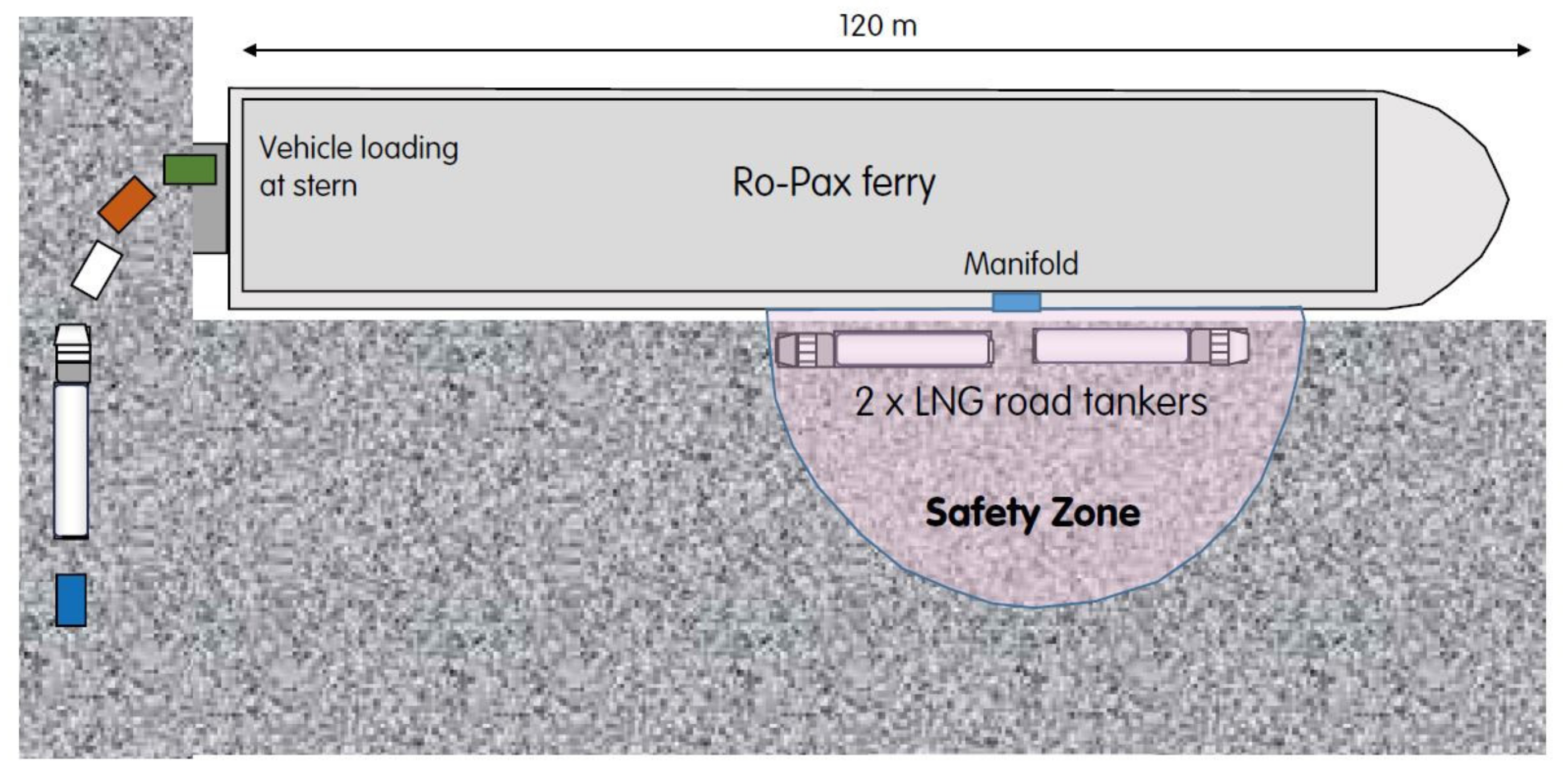
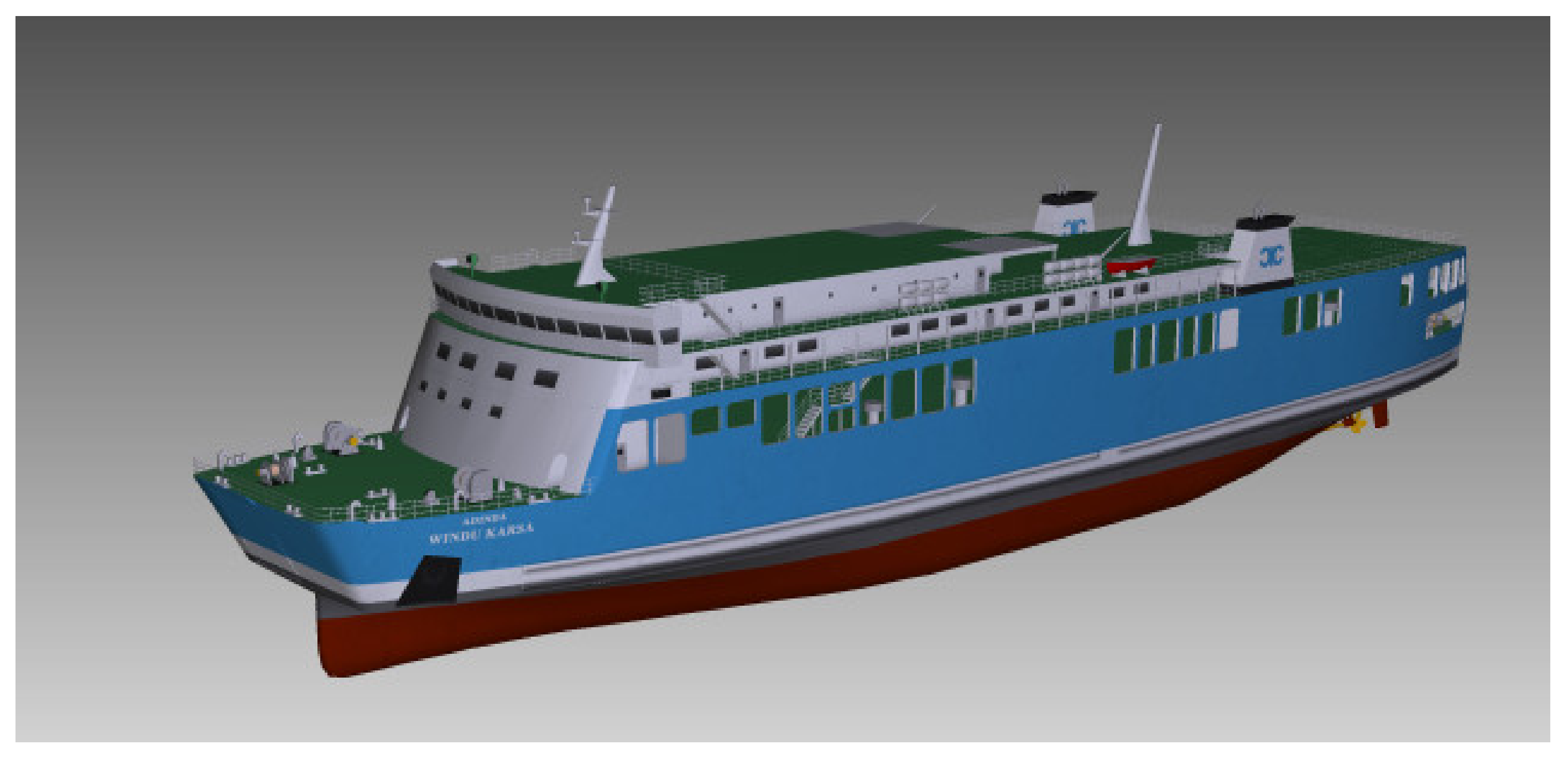


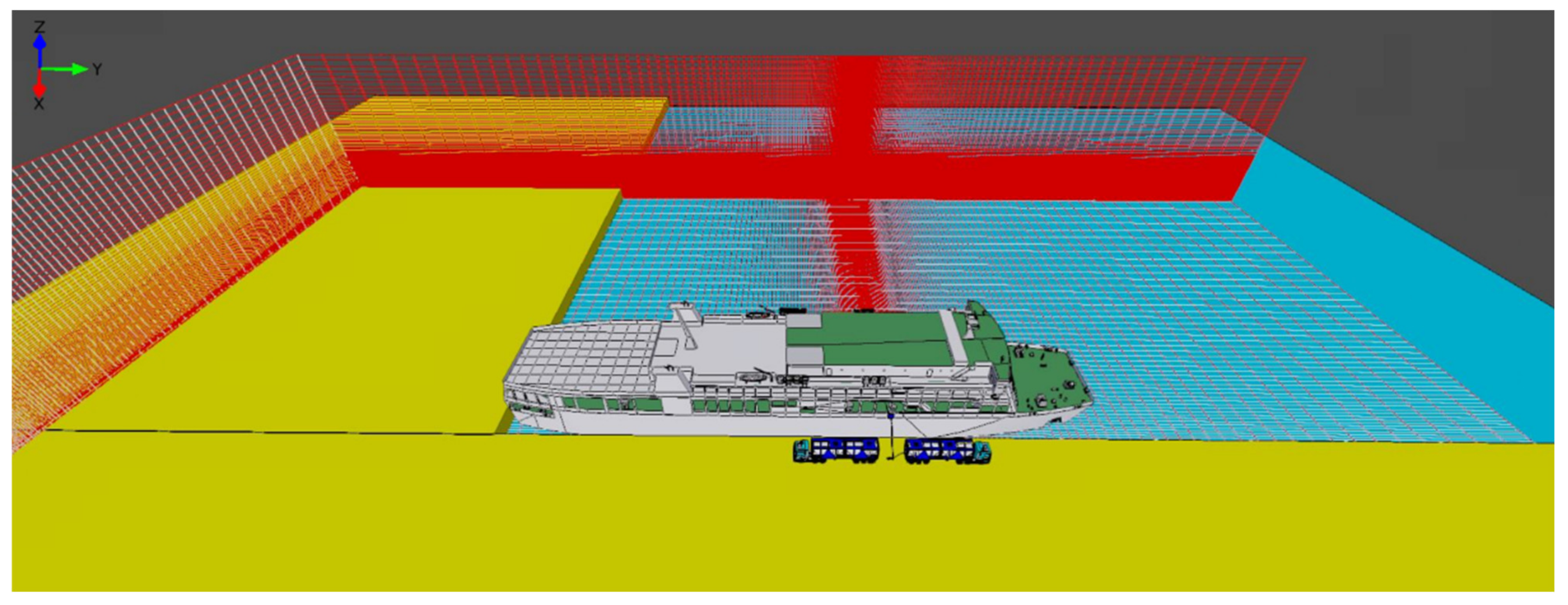

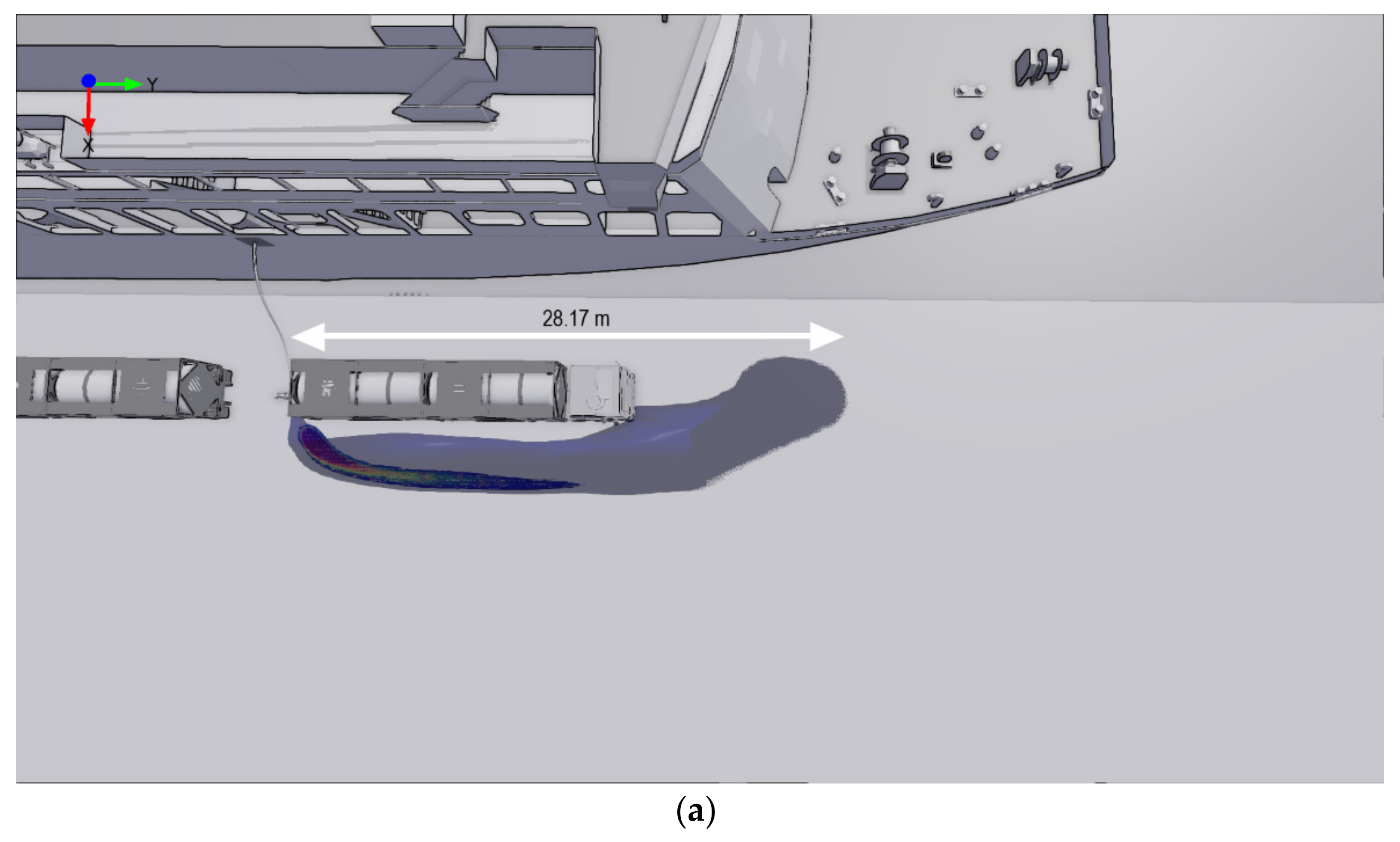
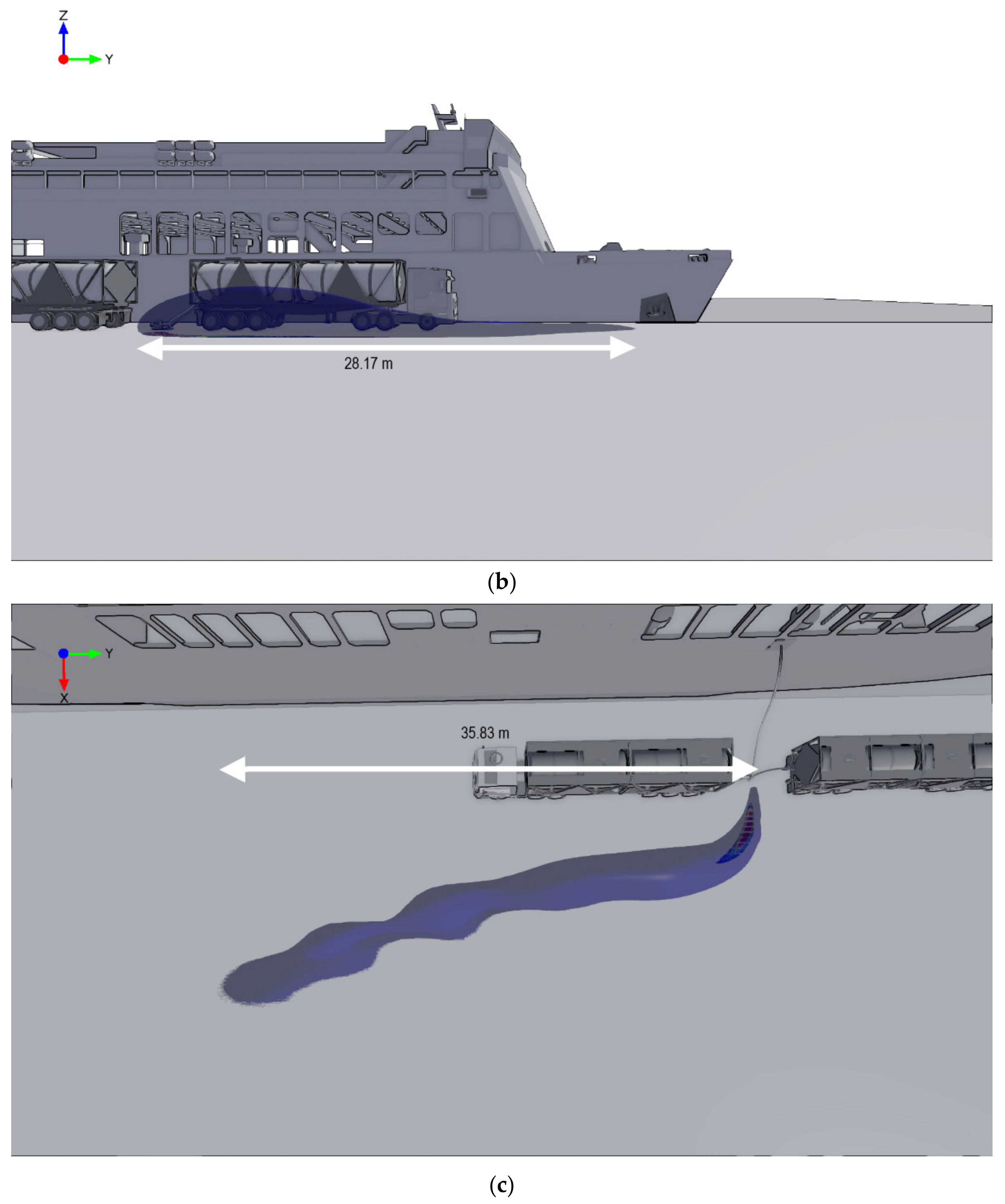
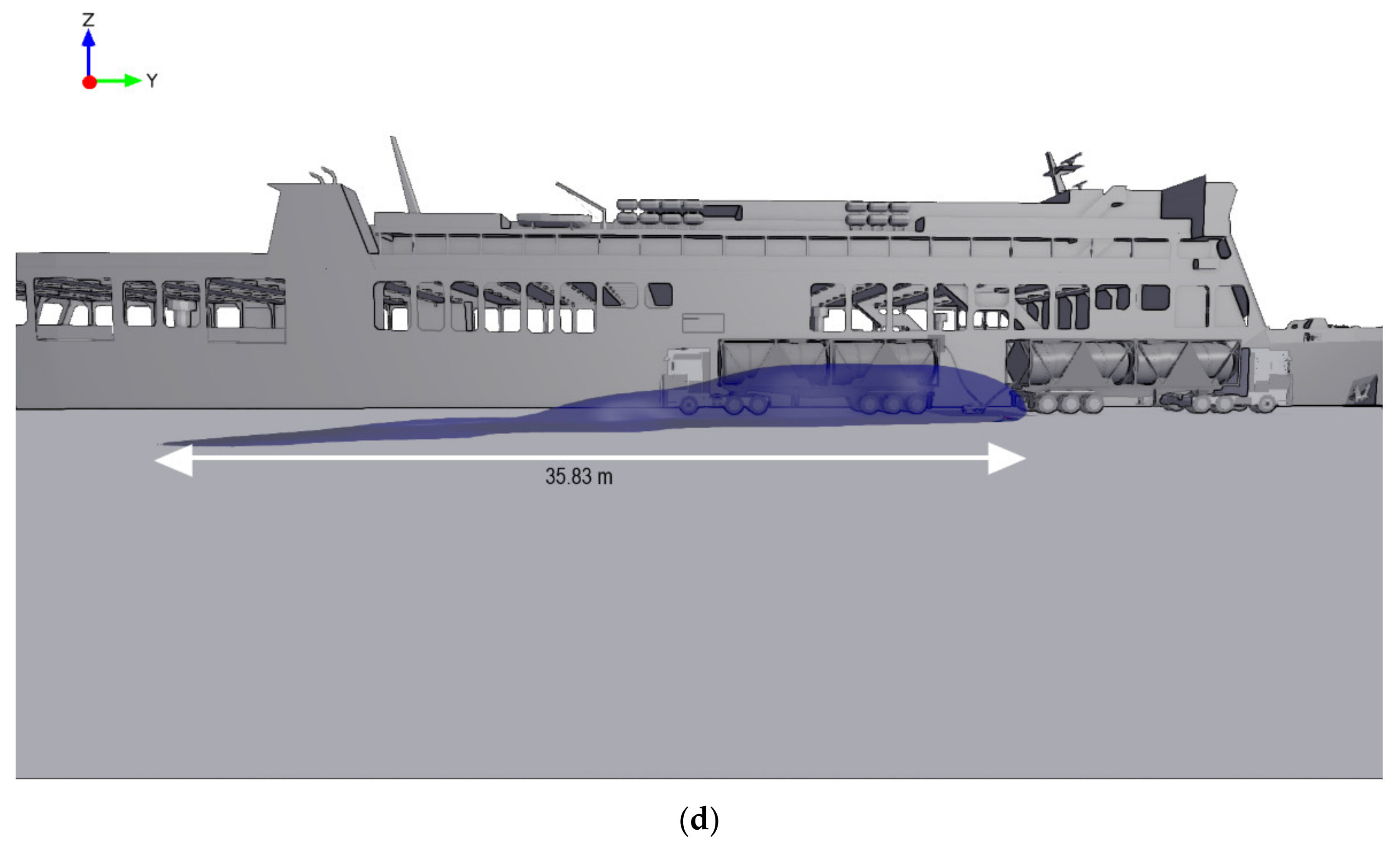
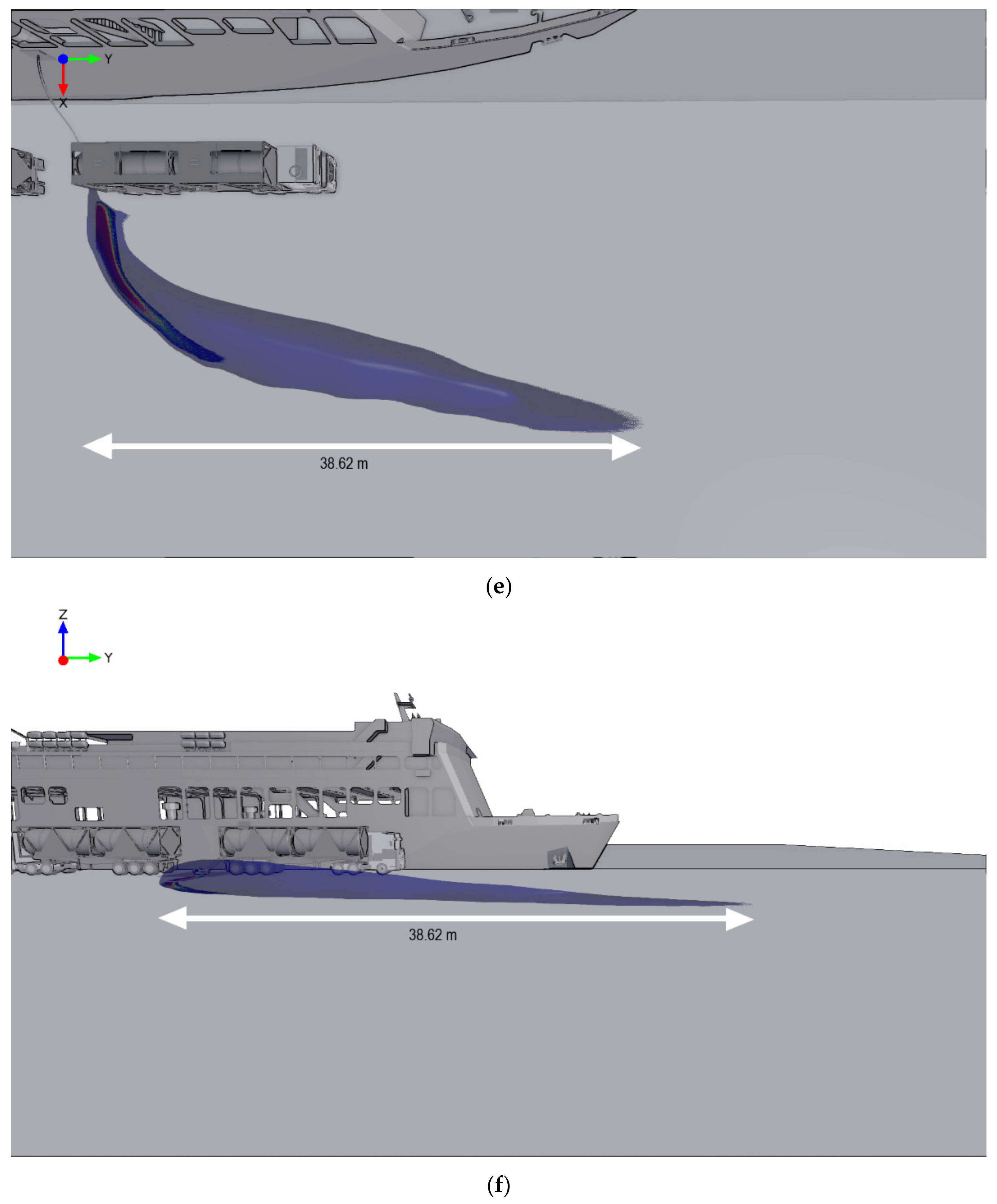
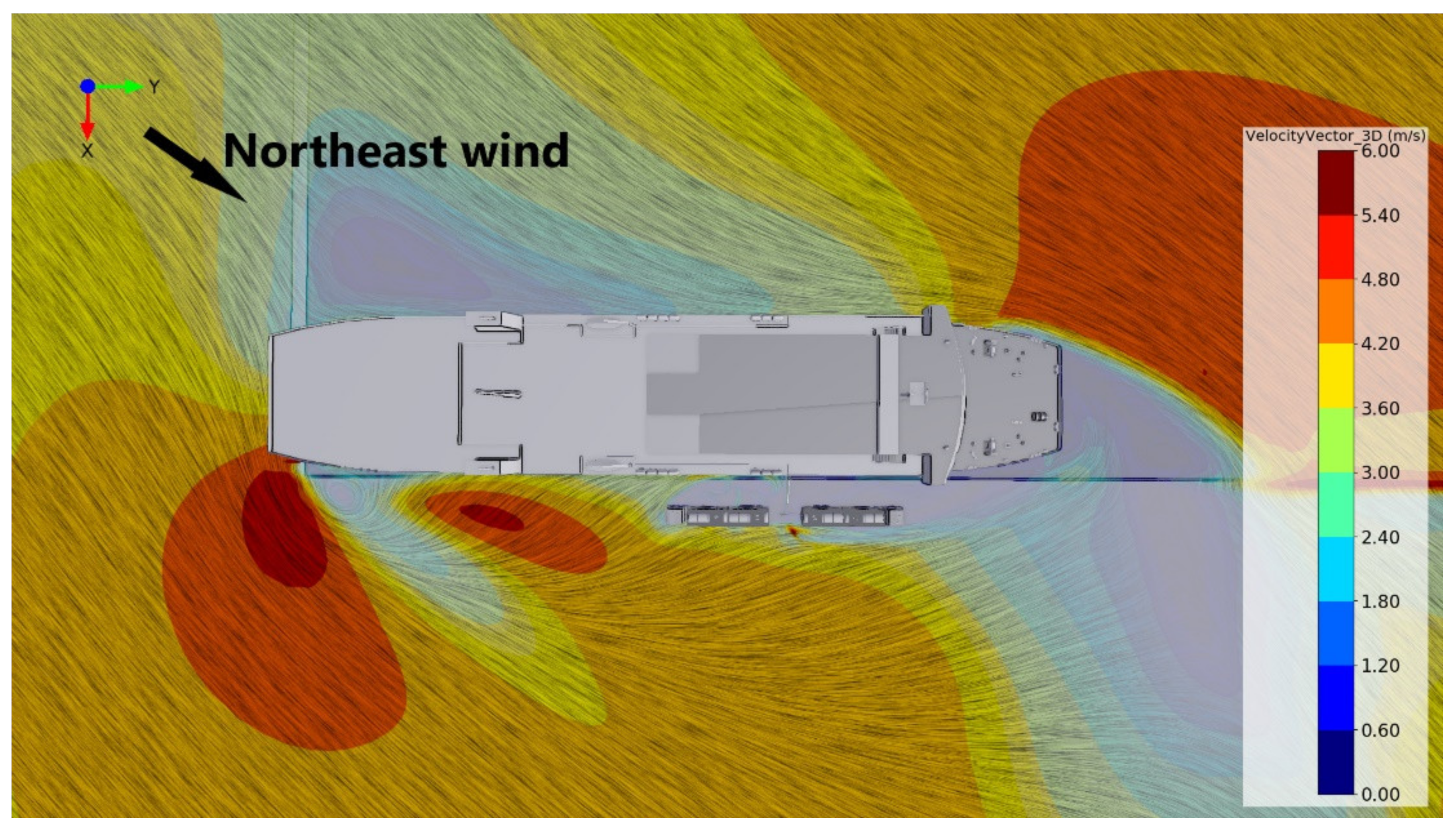
| Wind Speed (m/s) | Direction | Mesh Type | LFL Distance (m) | Difference Percentage from Coarse Grid (%) |
|---|---|---|---|---|
| 8.1 (mean) | South | Coarse | 23.03 | N/A |
| 90% mesh size | 21.07 | −8.51 | ||
| 85% mesh size | 25.38 | 10.20 | ||
| West | Coarse | 11.57 | N/A | |
| 90% mesh size | 11.87 | 2.59 | ||
| 85% mesh size | 12.27 | 6.05 | ||
| North | Coarse | 25.93 | N/A | |
| 90% mesh size | 27.17 | 4.78 | ||
| 85% mesh size | 27.22 | 4.97 | ||
| East | Coarse | 16.65 | N/A | |
| 90% mesh size | 17.88 | 7.39 | ||
| 85% mesh size | 16.98 | 1.98 |
| Wind Speed (m/s) | Direction | LFL Distance (m) | 130% LFL Distance (m) | GCI Study |
|---|---|---|---|---|
| 8.1 (mean) | South | 23.03 | 29.94 | Yes |
| South-West | 17.05 | 22.17 | No | |
| West | 11.57 | 15.04 | No | |
| North-West | 20.32 | 26.42 | No | |
| North | 25.93 | 33.71 | Yes | |
| North-East | 25.17 | 32.72 | Yes | |
| East | 16.65 | 21.65 | No | |
| South-East | 11.28 | 14.66 | No | |
| 5.7 (1 standard deviation) | South | 26.83 | 34.88 | Yes |
| South-West | 21.71 | 28.22 | Yes | |
| West | 20.65 | 26.85 | No | |
| North-West | 17.47 | 22.71 | No | |
| North | 21.07 | 27.39 | Yes | |
| North-East | 28.42 | 36.95 | Yes | |
| East | 20.65 | 26.85 | No | |
| South-East | 14.28 | 18.56 | No | |
| 3.3 (2 standard deviation) | South | 31.73 | 41.25 | Yes |
| South-West | 17.81 | 23.15 | No | |
| West | 29.95 | 38.94 | Yes | |
| North-West | 20.27 | 26.35 | No | |
| North | 29.37 | 38.18 | Yes | |
| North-East | 27.92 | 36.30 | Yes | |
| East | 26.15 | 34.00 | Yes | |
| South-East | 20.73 | 26.95 | No |
| Wind Speed (m/s) | Direction | GCI Value | LFL Distance (m) | LFL Distance Range (m) | BASiL Model Percentile Ranking |
|---|---|---|---|---|---|
| 8.1 (mean) | South | 0.098 | 25.53 | 23.03–28.03 | 79.40 |
| North | 0.017 | 26.37 | 25.93–26.81 | 121.59 | |
| North-East | 0.090 | 27.67 | 25.17–30.17 | 36.60 | |
| 5.7 (1 standard deviation) | South | 0.063 | 28.63 | 26.83–30.43 | 4.72 |
| South-West | 0.126 | 19.28 | 16.85–21.71 | 208.85 | |
| North | 0.225 | 27.17 | 21.07–33.27 | 48.61 | |
| North-East | 0.009 | 28.17 | 27.92–28.42 | N/A | |
| 3.3 (2 standard deviation) | South | 0.114 | 35.83 | 31.73–39.93 | N/A |
| West | 0.191 | 25.15 | 20.35–29.95 | 69.3 | |
| North | 0.240 | 38.62 | 29.37–47.87 | N/A | |
| North-East | 0.282 | 21.77 | 15.62–27.92 | 92.52 | |
| East | 0.048 | 24.95 | 23.75–26.15 | 135.42 |
| Wind Speed (m/s) | Direction | BASiL Model Safety Zone Exceeded |
|---|---|---|
| 8.1 (mean) | South | No |
| South-West | No | |
| West | No | |
| North-West | No | |
| North | No | |
| North-East | No | |
| East | No | |
| South-East | Uncertain | |
| 5.7 (1 standard deviation) | South | Uncertain |
| South-West | No | |
| West | No | |
| North-West | No | |
| North | Uncertain | |
| North-East | Yes | |
| East | No | |
| South-East | No | |
| 3.3 (2 standard deviation) | South | Yes |
| South-West | No | |
| West | No | |
| North-West | No | |
| North | Yes | |
| North-East | No | |
| East | No | |
| South-East | No |
Publisher’s Note: MDPI stays neutral with regard to jurisdictional claims in published maps and institutional affiliations. |
© 2022 by the authors. Licensee MDPI, Basel, Switzerland. This article is an open access article distributed under the terms and conditions of the Creative Commons Attribution (CC BY) license (https://creativecommons.org/licenses/by/4.0/).
Share and Cite
Lim, B.H.; Ng, E.Y.K. Comparison of FLACS and BASiL Model for Ro-Pax Ferry LNG Bunkering Leak Analysis. Fluids 2022, 7, 272. https://doi.org/10.3390/fluids7080272
Lim BH, Ng EYK. Comparison of FLACS and BASiL Model for Ro-Pax Ferry LNG Bunkering Leak Analysis. Fluids. 2022; 7(8):272. https://doi.org/10.3390/fluids7080272
Chicago/Turabian StyleLim, Boon How, and Eddie Y. K. Ng. 2022. "Comparison of FLACS and BASiL Model for Ro-Pax Ferry LNG Bunkering Leak Analysis" Fluids 7, no. 8: 272. https://doi.org/10.3390/fluids7080272
APA StyleLim, B. H., & Ng, E. Y. K. (2022). Comparison of FLACS and BASiL Model for Ro-Pax Ferry LNG Bunkering Leak Analysis. Fluids, 7(8), 272. https://doi.org/10.3390/fluids7080272







